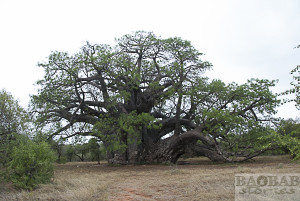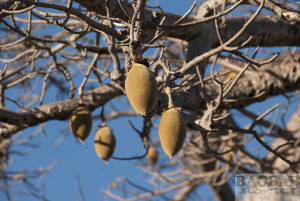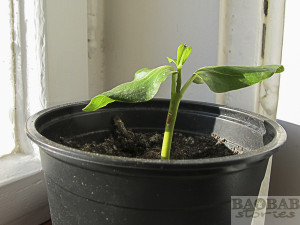Baobabs are giants and can grow to 1000 years of age and more under normal conditions. Thus they belong to the oldest and largest flowering trees on Earth. Baobabs do not count as endangered species – but competition rises in their habitats, particularly with respect to arable land for agricultural production.
The adventure of life begins for a Baobab with a drop off the parent tree. Ripe fruit fall from great height to the ground. The survival of a single seed from one tree growing into old age is enough to guarantee its reproduction. On first glimpse that does not sound very serious in terms of reproduction since an adult tree can produce over 200 fruit per season with each fruit bearing up to 300 seeds and more.
Ideal conditions are crucial for young baobab
Nevertheless ideal conditions for growth are crucial. Reproductive cycles in baobabs are not fully explored yet. Science calls it episodic reproduction, meaning that successful growth of baobabs cannot be assigned to clearly defined periods. Optimum conditions to appear for germination and growth of baobab offspring can take up to 100 years and more, depending on the region. Young trees need a good mix of different factors: sufficient amount of water in appropriate availability, heat, light and nutrients.
One of the most limiting factors is sufficient rainfall, as many baobabs grow in very dry areas. Especially seedlings need water frequently in order to grow. On the other hand, too much water can be harmful – the small roots might die of root rot. Survival becomes easier once the tree forms a taproot which saves water and can bridge periods without rain.
Development aid for baobab seeds
Seeds of baobabs are embedded in the powder of baobab fruit. They are about a centimeter in size and kidney-shaped. A hard seed shell protects its germinable core. The shell can proof to be an obstacle to successful germination. Sometimes bushfires make the seed shell permeable for water and nutrients and therefore support germination.
Nature has devised another trick: The fruit powder has a pleasant taste and is rich in nutrients which are not only appreciated by human beings. Elephants, monkeys and other animals love to eat it – and with the fruit powder they swallow the seeds. These migrate through the digestive tract. Digestive juices soften the hard seed coats, but do not destroy the inside. The seeds drop to the soil with the feces. The latter provides good fertilizer for a favorable growth environment. If temperatures and the amount of water is right, the seeds have a good start in life.
Natural threats Baobab Sprouts
Survival is not guaranteed – even if the seeds manage to germinate successfully. The first months and even years of life can still prove difficult. Cattle, goats, sheep and antelope like to eat leaves and shoots of young baobabs. Only at a growth height of about three meters, they are safe from browsing animals.
Even if they survive their first years reaching maturity is not guaranteed. Bush fires, unexpected climatic changes such as drought or frosts can destroy the giants. Nevertheless – the biggest threat to the trees comes from humans these days.
“Human factor”
In some parts of Africa, for example, in Tanzania, people grow cotton which is a land and labor intensive crop with high inputs of resources such as water, fertilizer and so on. The crop is susceptible to a pest called “Cotton Stainer”. The insect leaves red stains on cotton which ruins it for further marketing.
Unfortunately the bug lives on baobabs and the latter was considered to be its host. For this reason, baobabs were cleared off in some regions despite the fact that they were considered to be important trees traditionally. The alleged economic advantage suddenly became more important than the beneficial properties of the baobabs. Meanwhile the bug has been found to migrate to other “host plants” once the baobabs were cut off.
Fungus can harm baobabs
Fungus can inflict damage to the trees and make them die. The disease is known as “sooty disease”. It is easily recognizable because it leaves black spots on trunks and branches. Another cause for fungus and subsequent death is root rot which occurs if baobabs are forced to stand in water for too long.
In itself baobabs are frugal contemporaries that can survive well in dry and almost inhospitable areas with little rain and poor soils. However, considering the factors that must prevail for a baobab to grow into a specimen of 1000 years and more seems like a miracle – one can be called lucky to experience an old giant like that in the wild.







Pingback: What’s Up with Organic Certification or Labeling on Baobab Fruit Powder? – Oumou Khayri
Clearly looks like a worthy tree in dire need of human intervention to assure its continued propagation. Many factors seem to be stacked against the species.
Thank you William Flohr for your comment – yes, I am grateful that there are people around who have started to support the tree. Have a wonderful day & best regards, Heike Pander
Would be good to buy to get the naturally red stain cotton in order not the baobao to be cut. And sell garments with these color and an explanation.
Good idea, Ana Gonzales, and thank you for your comment!
Thx for this piece. I also needed to learn about the flowering, pollination to seed production cycle. Any hope of hearing about it here???
Hello Gideon Kasozi, thank you for your comment & interest in baobab. Yes, you may read more of that – for example here: https://baobabstories.com/en/biology/biology-flower/ and here you find mixed information about the topics you were looking for: https://baobabstories.com/en/biology/ – all the best, Heike
Thank you for this story. Can you tell us at what age a baobab becomes mature and produce its first fruits?
Some sources says it may start as soon as 8 years but some say not before 200 years!
Dear Andre, thank you for your interest in Baobab and your question – which is not easy to answer. In fact – the time frame you mentioned seems to be correct. The time when a baobab produces its fruit highly depends on the spot & area where it grows and the general living conditions. Baobabs in West Africa tend to produce fruit around the age of 10 to 15 years and in the southern African region for example around the age of 20. And I have indeed heard of baobabs in the Limpopo Province in South Africa that start to produce fruit at the age of 200 years – can you imagine? I hope my answer helps. Best regards, Heike
Thank you Heike ! I just complete the French Baobab wikipedia article with these informations.
After reading this i am inspired to mobilize young men and women in my Rural community to plant at least 10 baobab trees this coming rainy season
Hello Tawanda Mazango, thank you very much for your comment – it is highly appreciated & I like your project idea! Good luck & all the best! Kind regards,
Heike Pander
Hello Heike and all,
Am glad I found this site.
I live in Cyprus and I managed to grow 3 baobabs from seed.
They must be in their 4th year now. They are in 3 large pots at the no-cover balcony. I take them indoors when their leaves all go yellow before they all fall so they don’t rot because of rain(s) around October. And I take them out again at the end of April when i start to see green buds and start watering them.
I don’t water them during their dormant period.
Currently they are around 3 to 4 feet tall. I can send pics as well later on if an email is provided.
I would love to have one planted outside where there is a slope and rainwater can be prevented, but still not sure it will survive.
This is my second attempt as the first ones have died because of wet soil during dormant period. (experience!)
Just wanted to share my experience with baobabs.
Thanks,
Vas.
Hello Vas, thank you for your interest in Baobabs, your feedback on my website and for contacting me. I am not aware of the year-round weather conditions in Cyprus. All I can say is that baobabs do photosynthesis all year round and in the wild they mostly live under very hot and dry circumstances. I live in Germany and take my baobabs indoors as soon as the temperatures drop below 18 °C. Once temperatures drop below 12 ° C they might start to die slowly. During their dormant phase they like temperatures around 15 – 18 ° C and little water. If you managed to get them through their dormant phase without watering – fine. Mine do get water (maybe every 4 weeks or so) as they do not lie dormant totally – as I said, they do photosynthesis even if they do not have leaves. They have special cells below the surface of their outer bark layer. Wheather you can plant a baobab outdoors depends on the climate in Cyprus. As mentioned above: if it gets too cold, baobabs will eventually die. And they do not appreciate wet roots – so if it rains a lot during some parts of the year I would not plant my baobabs outside either. I rather keep them in pots and move them to dry spots. Another option is to plant a baobab in a green house outdoors. I have seen that but one has to be aware that they tend to grow quickly during their first years and gain in hight considerably.
As with respect to getting seeds to germinate: there are different ways to manage the task and the way I described on my website works fine for me. Apart from using acid on the seed coats I have tried most of the other means and peeling the seeds after soaking gave the best results as all of the seeds germinated. Kind regards, Heike
Also, how do they live by water and their roots (actually one big trunk root) don’t get rotten ?
https://en.wikipedia.org/wiki/Adansonia_digitata#/media/File:Adansonia_digitata_3_-_African_baobab.JPG
Kind regards,
Vas.
Hi Vas, the tree in the pic lives near the water (I have actually been there) but on a rocky outcrop. In this case shown on the pic I doubt that the tree still has got a big tap root. In their early years they have little tap roots that helps them to store water & nutrients. Later on they develop a widespread system of roots that does not reach into the soil very deep. Hope that helps. Kind regards, Heike
My baobabs have no leaves from November till nearly May. For the past 3 winters I haven’t watered them at all.
We do get wet and cold winters here in Cyprus. So planting outside is not an option then.
Thanks so much for all the information Heike. Appreciated.
Kind regards,
Vas.
Thanks a lot Vas & good luck with your baobabs – they are such interesting trees & long-term companions ! All the best, Heike
I have developed a passion for growing different types of trees from seeds.
I find the whole process very therapeutic .
From the picking of the seed,planting it ,see it sprout and nurse it till transplanting and beyond.
I have managed to get about 10 of baobab seedlings from seed so far .
Root rot is a challenge as I have lost about 3 seedlings this far.
I will not be deterred, will keep going with the objective of making a difference to the deforestation happening around and as well leaving a mark on this planet.
Best wishes
Magwaza
Dear Magwaza, thank you very much for your inspiring comment & keep on growing baobabs! Yes, the process of seeing plants grow is very beneficial to me, too. Keep up your great work & good luck with your tree project! Kind regards, Heike
Thank you for information on Baobab I love the tree and have some strange relationship with it. Thank you
Pieter Smit
Dear Pieter, thank you for getting in touch & enjoy the magnificent baobabs! Kind regards, Heike
Pingback: What’s Up with Organic Certification or Labeling on Baobab Fruit Powder? – Future Professoriate
Dear Future Professoriate, thank you for linking your article to my blogpost. I am afraid that something got mixed up. I wrote that some trees take up to 100 years and more in some regions where they grow. That does not mean that they take that time to produce fruit everywhere. In the west of the African continent the trees start producing fruit earlier – between 10 to 20 years of age! Kind regards, Heike